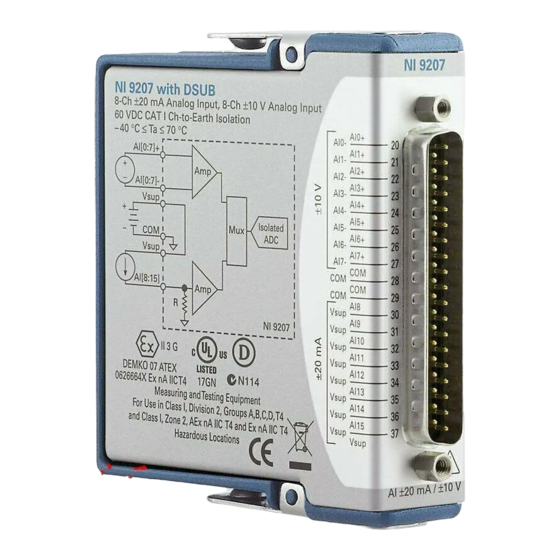
Table of Contents
Advertisement
Quick Links
Advertisement
Table of Contents

Summary of Contents for NI 9207
- Page 1 NI-9207...
- Page 2 GETTING STARTED GUIDE NI 9207 16 AI, ±20 mA/±10 V, 24 Bit, 500 S/s Aggregate...
-
Page 3: Safety Guidelines
This document explains how to connect to the NI 9207. In this document, the NI 9207 with spring terminal and the NI 9207 with DSUB are referred to inclusively as the NI 9207. Before you begin, complete the software and... - Page 4 115 V for U.S. or 230 V for Europe. Do not connect the NI 9207 to signals or use Caution for measurements within Measurement Categories III or IV. NI 9207 Getting Started Guide | © National Instruments | 3...
- Page 5 This category is for measurements of voltages from specially protected secondary circuits. Such voltage measurements include signal levels, special equipment, limited-energy parts of equipment, circuits powered by regulated low-voltage sources, and electronics. 4 | ni.com | NI 9207 Getting Started Guide...
-
Page 6: Safety Guidelines For Hazardous Locations
CAT III, or CAT IV. Safety Guidelines for Hazardous Locations The NI 9207 is suitable for use in Class I, Division 2, Groups A, B, C, D, T4 hazardous locations; Class I, Zone 2, AEx nA IIC T4 and Ex nA IIC T4 hazardous locations; and nonhazardous locations only. - Page 7 II 3G and is suitable for use in Zone 2 hazardous locations, in ambient temperatures of -40 °C ≤ Ta ≤ 70 °C. If you are using the NI 9207 in Gas Group IIC hazardous locations, you must use the device in an NI chassis that has been evaluated as Ex nC IIC T4, Ex IIC T4, Ex nA IIC T4, or Ex nL IIC T4 equipment.
-
Page 8: Electromagnetic Compatibility Guidelines
(EMC) stated in the product specifications. These requirements and limits provide reasonable protection against harmful interference when the product is operated in the intended operational electromagnetic environment. NI 9207 Getting Started Guide | © National Instruments | 7... - Page 9 To ensure the specified EMC performance, Caution operate the NI 9207 with DSUB only with shielded cables and accessories. Do not use unshielded cables or accessories unless they are installed in a shielded...
-
Page 10: Special Conditions For Marine Applications
In addition, take precautions when designing, selecting, and installing measurement probes and cables to ensure that the desired EMC performance is attained. NI 9207 Getting Started Guide | © National Instruments | 9... -
Page 11: Preparing The Environment
Preparing the Environment Ensure that the environment in which you are using the NI 9207 meets the following specifications. Operating temperature -40 °C to 70 °C (IEC 60068-2-1, IEC 60068-2-2) Operating humidity 10% RH to 90% RH, (IEC 60068-2-78) noncondensing... - Page 12 Vsup AI10 Vsup Vsup AI11 Vsup AI10 Vsup AI11 AI12 Vsup Vsup AI12 AI13 Vsup Vsup AI13 AI14 Vsup Vsup AI14 Vsup AI15 Vsup AI15 Vsup Vsup Vsup Vsup NI 9207 Getting Started Guide | © National Instruments | 11...
- Page 13 Table 1. Signal Descriptions Signal Description Positive analog input voltage connection Negative analog input signal connection Analog input current connection Vsup Voltage supply connection Common reference connection to isolated ground 12 | ni.com | NI 9207 Getting Started Guide...
-
Page 14: Floating Differential Connections
Floating Differential Connections AI0+ Voltage – AI0– Source 1 MΩ Resistor NI 9207 Grounded Connections AI0+ – AI0– Voltage Source NI 9207 NI 9207 Getting Started Guide | © National Instruments | 13... -
Page 15: Single-Ended Connections
Connecting an External Power Supply You must connect an external power supply with a 0 to 30 V voltage range to the NI 9207. This power supply provides the current for the devices you connect to the module. You can connect only one external voltage supply to the NI 9207. -
Page 16: Connecting A Loop-Powered Current Transducer
Do not remove or insert modules if the Caution external power supply connected to the Vsup and COM pins is powered on. Connecting a Loop-Powered Current Transducer External Power Supply – Loop-Powered Current Transducer NI 9207 NI 9207 Getting Started Guide | © National Instruments | 15... -
Page 17: Connecting A Three-Wire Current Transducer
Connecting a Three-Wire Current Transducer External Power Supply Three-Wire Current – Transducer NI 9207 16 | ni.com | NI 9207 Getting Started Guide... -
Page 18: High-Vibration Application Connections
NI 9207 Connection Guidelines • Make sure that devices you connect to the NI 9207 are compatible with the module specifications. • You must use 2-wire ferrules to create a secure connection when connecting more than one wire to a single terminal on the NI 9207 with spring terminal. -
Page 19: Where To Go Next
NI 9207 Datasheet NI 9207 Datasheet NI-RIO Help NI-DAQmx Help LabVIEW FPGA Help LabVIEW Help RELATED INFORMATION C Series Documentation Services & Resources ni.com/services ni.com/info cseriesdoc Located at ni.com/manuals Installs with the software 18 | ni.com | NI 9207 Getting Started Guide... -
Page 20: Worldwide Support And Services
You can obtain the DoC for your product by visiting ni.com/certification. If your product supports calibration, you can obtain the calibration certificate for your product at ni.com/calibration. NI 9207 Getting Started Guide | © National Instruments | 19... - Page 21 National Instruments Patent Notice at . You can find information about end-user license agreements (EULAs) and third-party legal notices in the readme file for your NI product. ni.com/legal/export-compliance Refer to the Export Compliance Information at for the NI global trade compliance policy and how to obtain relevant HTS codes, ECCNs, and other import/ export data.
















Need help?
Do you have a question about the 9207 and is the answer not in the manual?
Questions and answers